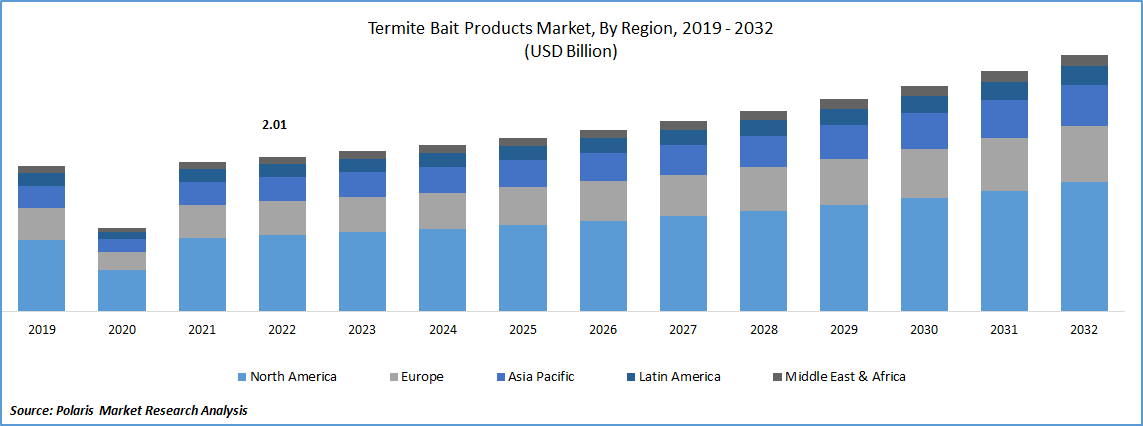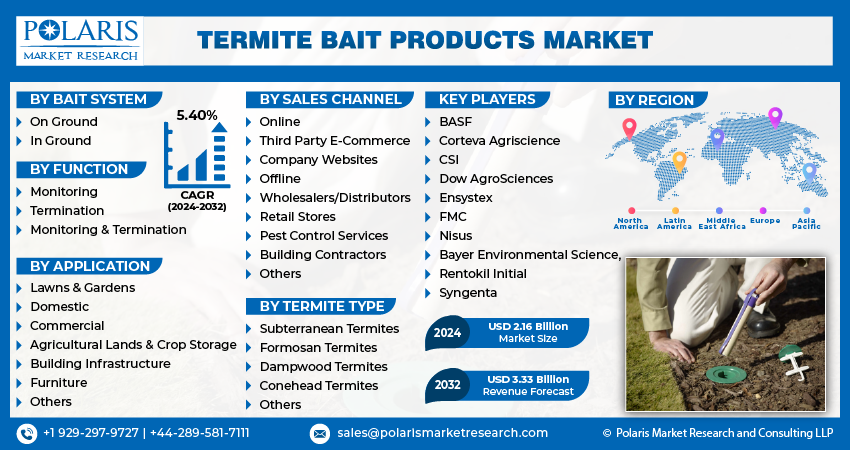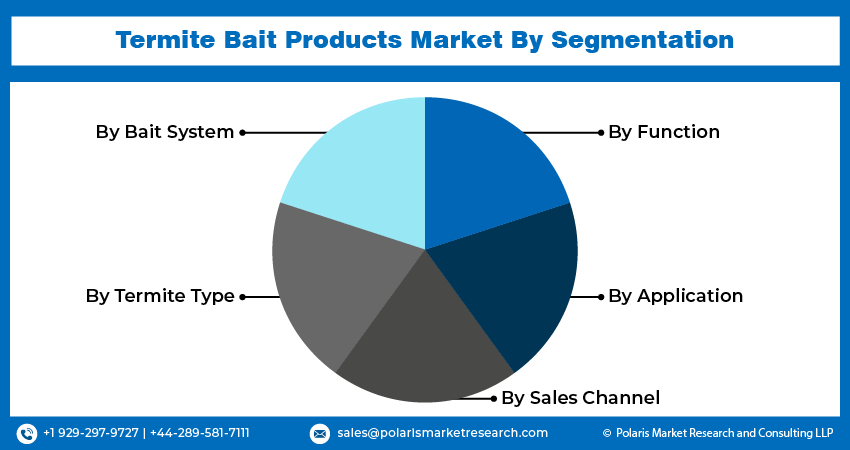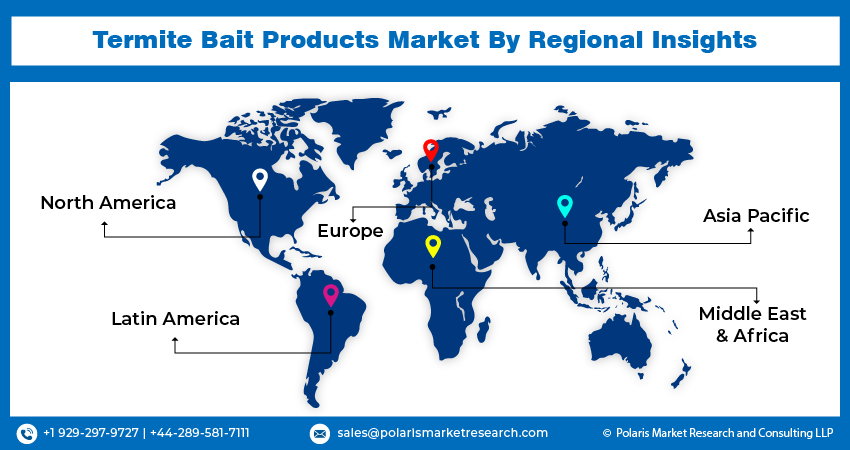
Termite Bait Products Market Share, Size, Trends, Industry Analysis Report, By Bait System (On ground, In ground); By Termite Type; By Function; By Application; By Sales Channel; By Region; Segment Forecast, 2024 - 2032
- Published Date:Jan-2024
- Pages: 114
- Format: PDF
- Report ID: PM3697
- Base Year: 2023
- Historical Data: 2019-2022
Report Outlook
The global termite bait products market was valued at USD 2.08 billion in 2023 and is expected to grow at a CAGR of 5.40% during the forecast period.
The evolution of termite control methods and the growing emphasis on human and environmental health have led to the development and adoption of alternative approaches to traditional soil termiticides. Among these alternatives, termite baiting products have emerged as an effective and environmentally friendly solution for termite control.

To Understand More About this Research: Request a Free Sample Report
The increasing use of termite bait products, incorporating active ingredients like Chlorfluazuron or hexaflumuron, is a key driver behind the growth of the market. These products leverage the unique biology and behavior of termites to effectively control and eliminate termite infestations.
The active ingredients in termite bait products function as Insect Growth Regulators (IGRs), specifically targeting the growth and development of termites by impeding the synthesis of chitin, a crucial component of their exoskeleton. This disruption prevents termites from forming a new exoskeleton after molting, leading to their ultimate elimination.
Industry Dynamics
Growth Drivers
Increasing need for effective and environmentally friendly solutions for termite control
The main factor driving the growth of the termite bait products market is the increasing need for effective and environmentally friendly solutions for termite control. Termite bait products offer a more environmentally friendly alternative to traditional chemical treatments. They typically utilize active ingredients that have lower toxicity and limited impact on non-target organisms. This aspect appeals to consumers who prioritize sustainable and eco-friendly pest control methods, contributing to the growth of the market. The expansion of urban areas and changing climatic conditions contribute to the spread of termites into previously unaffected regions. As termite habitats expand, there is a greater need for localized termite control measures. Termite bait products, with their targeted approach and versatility, can be employed in various environments, making them suitable for addressing termite infestations in both traditional and emerging termite-prone areas.

Report Segmentation
The market is primarily segmented based on bait system, termite type, function, application, sales channel and region.
|
By Bait System |
By Termite Type |
By Function |
By Application |
By Sales Channel |
By Region |
|
|
|
|
|
|
To Understand the Scope of this Report: Speak to Analyst
By Bait System Analysis
In Ground bait system is expected to witness fastest growth
In Ground bait system is projected to have faster growth for the market. These systems are specifically designed to target termites that reside in the soil around structures. These systems consist of bait stations that are strategically placed in the ground near areas prone to termite activity. Termites forage for food sources in the soil, making in-ground bait stations an effective method to intercept and eliminate termite colonies. The use of in-ground termite bait products allows for targeted and localized treatment, focusing on the areas where termites are active. These baiting systems offer preventive measures and early detection capabilities.
By Termite Type
Subterranean segment accounted for the largest market share
Sub-terranean segment holds the largest market share for the market in the study period. These termites are the most common type of termites and are found in various regions around the world. Their widespread presence creates a significant demand for effective termite control solutions. This has led to increased research, development, and production of bait products specifically designed to target subterranean termites. They are highly destructive pests that can cause significant damage to structures made of wood. They feed on cellulose materials found in wooden beams, furniture, and other wooden components of buildings. The economic impact of subterranean termite damage has driven the need for effective control methods, leading to the growth of the market.
By Function Analysis
Monitoring & Termination segment is expected to hold the larger revenue share
Monitoring & termination segment is projected to witness a larger revenue share in the coming years. It offers a comprehensive solution for termite control. It combines both monitoring and termination functions within a single product or system. This comprehensive approach appeals to customers who are looking for an all-in-one solution to detect termite activity early and effectively eliminate termite colonies. The convenience and efficiency of a single product catering to both monitoring and termination needs drive its popularity. There is an increasing emphasis on proactive termite management.
By Application Analysis
Lawns & Gardens segment is projected to witness higher growth
Lawns & Gardens Segment is expected to have higher growth in the forecast period. Lawns and gardens are an integral part of residential properties, and homeowners often invest time, effort, and resources into maintaining their outdoor spaces. Termites can pose a threat to lawns, plants, trees, and wooden structures like fences, decks, or garden sheds. Therefore, homeowners who value their lawns and gardens seek effective termite control solutions to protect their outdoor spaces from termite damage. Termite bait products offer a targeted and efficient approach to manage termite populations in residential lawns and gardens. Lawns and gardens contribute to the aesthetic appeal of residential properties.

Regional Insights
North America garnered with the larger revenue share in the forecast time frame
North America is expected to witness a larger revenue share for the market. The potential impact of global warming on termite populations is likely to result in their ability to thrive in previously uninhabited areas. This phenomenon could lead to increased termite pressure in regions of the United States that typically experience moderate levels of termite activity, such as the mid-West. Moreover, there is a possibility of the aggressive Formosan termite expanding its range beyond its traditional habitat around the Gulf coast and affecting areas along the southern Atlantic coast and parts of California.
If global warming continues, these regions in the U.S. may face heightened termite pressure and a potential invasion by the Formosan termite. The implications of these shifts in termite distribution patterns could drive the demand for termite control solutions, including termite bait products, as homeowners, property managers, and construction professionals seek effective measures to protect their properties from termite damage. Therefore, the anticipated effects of global warming on termite behavior and the potential expansion of termite populations in previously unaffected regions can contribute to the growth of the termite bait products market in North America.
Europe is projected to witness a higher growth rate for the market. The presence of various wood-destroying termite species in Europe, such as Reticulitermes santonensis, Reticulitermes lucifugus, and Kallotermes flavicollis, can drive the growth of the termite bait products market in the region. The identification and prevalence of these termite species highlight the need for effective termite control measures, including the use of termite bait products, to mitigate the potential damage they can cause to wooden structures and properties. Homeowners, property managers, and professionals in these areas may seek effective measures to protect their properties from termite infestations and subsequent damage. This creates an opportunity for the termite bait products market to cater to the specific needs of these regions, providing targeted solutions to combat the wood-destroying termite species present in Europe.

Key Market Players & Competitive Insights
The termite bait products market is fragmented and is anticipated to witness competition due to several players' presence. Major players in the market are constantly launching novel products & extending their product line to stay ahead of the competition. These players focus on partnership, product upgrades, and collaboration to gain a competitive edge over their peers and capture a significant market share.
Some of the major players operating in the global market include:
- BASF
- Bayer Environmental Science,
- Corteva Agriscience
- CSI
- Dow AgroSciences
- Ensystex
- FMC
- Nisus
- Rentokil Initial
- Syngenta
Recent Developments
- In April 2023, Recent study focused on western subterranean termites in California, known for its hot-summer Mediterranean climate. The results showed that termite foraging was primarily observed during winter and spring, with a significant difference in time-to-attack between stations installed in winter versus summer.
- In March 2022, BASF, renowned worldwide as a leading innovator in the field of termite control, launched its new advanced trelona advanced bait system. Trelona utilizes the power of Novaluron to ensure the complete elimination of termite colonies.
Termite Bait Products Market Report Scope
|
Report Attributes |
Details |
|
Market size value in 2024 |
USD 2.16 billion |
|
Revenue forecast in 2032 |
USD 3.33 billion |
|
CAGR |
5.40% from 2024 - 2032 |
|
Base year |
2023 |
|
Historical data |
2019 - 2022 |
|
Forecast period |
2024 - 2032 |
|
Quantitative units |
Revenue in USD billion and CAGR from 2024 to 2032 |
|
Segments covered |
By Bait System, By Termite Type, By Function, By Application, By Sales Channel, By Region |
|
Regional scope |
North America, Europe, Asia Pacific, Latin America, Middle East & Africa |
|
Key companies |
BASF, Dow AgroSciences, Syngenta, Bayer Environmental Science, Rentokil Initial, FMC, Corteva Agriscience, Ensystex, Nisus & CSI. |
FAQ's
The global termite bait products market size is expected to reach USD 3.33 billion by 2032.
Key players in the termite bait products market are BASF, Dow AgroSciences, Syngenta, Bayer Environmental Science.
North America contribute notably towards the global termite bait products market.
The global termite bait products market is expected to grow at a CAGR of 5.37% during the forecast period.
The termite bait products market report covering key segments are bait system, termite type, function, application, sales channel and region.
